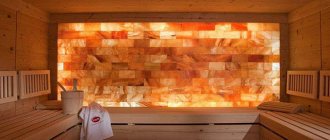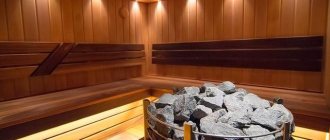A visit to the bathhouse is not only a pleasant pastime, but also a health procedure that helps strengthen the body and cure various diseases. Do you want to increase your health benefits? Himalayan salt is an environmentally friendly substance that has healing properties.
What is Himalayan salt
Himalayan salt is also suitable for cooking dishes, making them more piquant and delicious.
This is rock salt that is mined in Pakistan from the Khewra salt mine. It is located just 300 km from the Himalayan mountain range, which is why the mineral bears this name. According to the latest research, this salt was formed during the Jurassic period during volcanic processes between India and Eurasia. It appeared simultaneously with the Himalayas, after which it began to slowly settle down and accumulate - this is how the deposits that are now developed by people were formed.
Features of Himalayan salt are as follows:
- salty-sweet taste, unlike ordinary table salt;
- soft pleasant aroma;
- pink-orange color due to impurities of iron and other minerals;
- about 90 different microelements in the composition;
- 100% digestibility by the body;
- the lowest content of sodium chloride among all types of salt (for example, table salt consists of 98% of it, which is why it is harmful in large quantities);
- manual mining without the use of machines or explosives;
- no refining;
There are other deposits in different countries, but all of them are one way or another close to the Himalayas
Most often, the mineral has a pink or reddish color, but a black tint is also observed. This unusual color scheme makes the Khewra mine a popular tourist attraction. Among all the salt mines, including the extraction of ordinary table salt, Khewra ranks second in terms of production volumes, and third in terms of mineral reserves.
Black Himalayan salt is very similar to pink salt in structure and nature. It is distinguished by a pungent odor of hydrogen sulfide, but when heated it completely disappears. Black salt is also suitable for consumption. Hindus add it to traditional spices and to the national dish raita.
Panel
A salt panel can consist entirely of salt blocks or be combined: have inserts made of wood, porcelain stoneware, or stone. Finished surfaces can be of any geometry and relief. Depending on the blocks used, the panels are:
- smooth;
- polished;
- voluminous, with natural relief.
The surface can be made from light or darker blocks, based on your own preferences and interior tasks. salt wall lighting will help with this , which needs to be planned at the installation stage.
Useful properties of the mineral
Himalayan salt is a complex healing mineral. It is recommended not only by practitioners of alternative medicine, but also by doctors with good education and extensive experience. Salt has the following beneficial properties:
- supplies the body with important microelements (for example, iron, the lack of which is felt by many city residents);
- Helps cleanse the body and remove toxins;
- accelerates the restoration of damaged cells;
- calms the nerves;
- tones all the muscles of the body;
- kills harmful bacteria;
- externally rejuvenates the body;
- increases blood flow to the extremities (useful for people whose hands and feet are always cold).
Medical recommendations for the use of salt from the Himalayas boil down to the enormous benefits of its evaporation. The mineral evaporates when heated - both during cooking and during bath procedures. Salt vapors can treat a number of diseases:
- diseases of the digestive system;
- ailments of the genitourinary system;
- asthma;
- problems with the musculoskeletal system;
- vascular and heart diseases;
- hypertension;
- psoriasis, dermatitis and other skin problems;
- allergic reactions;
- irritation and inflammation of the gums;
- chronic fatigue.
You can also rinse your mouth with a salt solution to achieve fresh breath. And compresses or baths with saline solution relieve swelling on the legs and remove blue bags under the eyes.
Salty steam
In order to effectively saturate the air in the steam room with the healing components of a natural mineral, it is recommended to prepare a solution of salt in water and splash it on the heater. To do this, add 1-1.5 g of crystals to 1 liter of water, use the liquid after the solid particles have completely dissolved.
It is noteworthy that it is difficult to overdo it with introducing salt into the body using the above methods, but there is a therapeutic and health effect. However, it would be advisable to consult a doctor to eliminate the risk of unforeseen situations.
Can it harm
Like any type of this mineral, Himalayan salt is harmful only in excess quantities. Its evaporation does not have a negative impact - you can at least build a bathhouse entirely from salt bricks. But you should consume salt internally in moderation: it still contains sodium chloride, albeit in relatively small quantities (from 15% to 20%).
Contraindications for interaction with Himalayan salt:
- malignant tumors (however, for benign ones, you must ask your doctor’s permission before using the mineral);
- blood diseases;
- thrombophlembitis;
- pregnancy;
- renal failure.
If you have any of the above problems, you must refrain not only from using Himalayan salt, but also from bath procedures in general. Its use should also be avoided if you have an intolerance or hypersensitivity to sodium chloride.
You should be wary of low-quality fakes. Often, under the guise of real salt from the Himalayas, they sell rock or sea salt, tinted pink. Such a counterfeit can harm the body due to dye fumes.
Peculiarities
Himalayan salt is a mineral mined from the mines of Pakistan, which are located just near the Himalayas. This is where the name actually comes from. There is information that salt is also mined in India. It is believed that this mineral first appeared more than two hundred million years ago. This type of salt is considered the purest in the entire globe. Although some experts claim that in terms of its composition it is no worse or better than regular cooking, it only costs several times more.
All the healing properties of the Himalayan mineral can be fully revealed only under the influence of high temperature, which is why salt is best used in steam rooms.
It is worth understanding that only real Himalayan salt can bring benefits. Despite its wide availability, counterfeit salts still exist, and unscrupulous sellers often pass off other varieties of pink salt as Himalayan salt. Other minerals most likely will not cause harm, but they will probably not provide the desired benefit either.
It is very important in this case to check the salt supplier and manufacturer
How to use it correctly in a bath
The use of the mineral in saunas, baths and steam rooms has a healing effect. Also, the evaporation of the mineral promotes weight loss and accelerates fat burning. Of course, you shouldn’t expect miracles: without proper nutrition and exercise, you’ll hardly be able to lose many kilograms. But the correct use of salt during bath procedures allows you to achieve impressive results.
Not everyone can afford to build one or more walls from Himalayan salt.
There are several ways to use the mineral:
- Construction of walls. Salt bricks, slabs or other types of blocks are usually used for this. The brick is pure Himalayan salt, and the slab or block is a mineral that has been processed and added with building impurities. Therefore, bricks are considered the best option, although they are more expensive. All four walls will cost a pretty penny, so you can get by with just one - this will be quite enough to achieve a noticeable effect from the Himalayan salt.
- Laying the floor. If the floor of the bathhouse is made of salt bricks, then you can safely walk on it barefoot. If the bathhouse has been built a long time ago, you can remove the old floor and replace it with salt flooring. The effect of bath procedures will be the same as with a salt wall.
- Salt pebbles. Large smooth stones made entirely of salt should be placed on hot stones in the steam room before pouring water on them. This allows you to achieve maximum effect due to abundant evaporation.
- Installation of various decorative elements. Lampshades, bowls with Himalayan salt, panels, etc.
Himalayan salt can also be used to line the floor of a bathhouse.
When using Himalayan salt, you should follow the following basic rules:
- the humidity level in the room should not be higher than 53% when the sauna is not in use (a short-term increase in humidity during use does not harm the salt bricks);
- walls and floors made of salt must be wiped with a dry towel to remove excess moisture;
- do not forget about ventilation;
- Installation of a ventilation system is highly recommended.
There is no need to be afraid of high temperatures. Salt can withstand temperatures up to 500 degrees Celsius, so you can even build fireplaces from it. Moreover, the higher the temperature, the more intense the healing fumes.
Panels
Small islands made of natural material are an interesting design technique that will pay off when decorating a sauna or bathhouse. Such fragments can be created from a whole panel or using a salt tile with a cut .
Inserts can be of different shapes, implemented in the form of horizontal or vertical stripes. By installing a light source around or behind the panel, you will get an unusual effect of a soft, warm glow. The salt wall in the bathhouse is suitable for decorating the hearth, the inside of the fireplace.
Types and installation of products made from Himalayan salt
Of course, not everyone wants to spend money on building an entire wall out of Himalayan salt or laying a floor with it. There are many more economical uses of this mineral in baths. The most popular installation methods:
- shade;
- bowl;
- panel;
- lamp.
Lampshade with salt
A lampshade is a good decorative element, but in a bathhouse it also serves a practical function. After all, the lighting device hidden behind the lampshade is used in conditions of high temperatures. So it should be:
- reliable in design;
- made from durable materials;
- moisture resistant;
- fireproof.
A lampshade made of wood with Himalayan salt will fit perfectly into the interior of the bathhouse.
Most often, lampshades are placed in the corners of the bathhouse directly under the ceiling or even close to it. There is a lighting fixture in the very corner, and between it and the wall of the lampshade, as can be seen in the photograph, there are Himalayan salt stones.
Materials from which you can make a lampshade for a bath:
- Tree. This option is good because the walls of the room are most often decorated with wood, and therefore the lampshade fits well into the interior. Also in favor of wood are its naturalness and environmental friendliness.
- Heat-resistant plastic, aluminum or stainless steel. These materials can be put on the same level, because they are slightly inferior to wood due to their chemical composition.
- Durable frosted glass. Used for decorative purposes, it provides endless design possibilities.
- Himalayan salt. Sometimes the lampshade is made from salt slabs. It's not cheap, but it's very effective.
Bowl of salt
The bowl is perhaps the most budget option. To bring it to life, you just need to buy a decorative bowl that would fit the interior of the bathhouse, place Himalayan salt inside in any form (pebbles are most often used) and hang it from the ceiling or wall mount. The materials are absolutely unlimited; the choice of appearance and shape of the bowl depends on the taste of the owner.
It is recommended to place the bowl close to the heat source so that the evaporation of the Himalayan salt is as intense as possible.
Decorative panel
This use of Himalayan salt is expensive, but very beautiful. It involves the creation of wall panels from salt stones and figured products. The panel is attached to the wall or, preferably, built directly into it.
The panel will look especially impressive if you place beautiful lighting inside the wall. After all, translucent salt will not only transmit light, but also scatter it beautifully, creating a unique atmosphere in the bathhouse
A Himalayan salt panel can have absolutely any shape and size.
The photographs show only two options for creating such decorative panels. Manufacturing methods are limited only by the author's imagination. You can also find ready-made panels made of Himalayan salt for sale.
Himalayan salt lamp
This method of using the mineral is quite unusual. The essence of such a lamp is a large salt stone, inside of which a light bulb is installed. Most often it is mounted on a stand, but there are also options that can be hung on the wall or hooked to the ceiling.
Lighting fixtures made from Himalayan salt are divided into 2 categories:
- natural (stone in its natural form);
- with decorative processing (some kind of pyramid or other figure is carved from stone).
It is advisable to install at least 3-4 such lamps to achieve maximum effect
For medicinal purposes, it is better to use natural lamps, because the fumes from them are more active.
Where fish splashed yesterday, dynamite explodes blocks
Lines from a famous poem from the era of widespread industrialization, in principle, correctly reflect the main milestones in the process of the birth of a salt deposit and its development. Only the fish splashed, for a minute, not yesterday, but a million years ago. And practically no one opens a salt massif with dynamite. There are other methods and other tools for this, more elegant.
Main salt extraction methods:
- Evaporation - evaporation of salt from a brine solution. This method is quite expensive in terms of energy consumption, but it allows one to obtain secondary salt with a low content of accompanying impurities. In the Russian North, the Pomors somewhat improved this method and divided it into stages. First, the brine was frozen, increasing its concentration due to the freezing of fresh water, and only then evaporated;
- Self-settling is a method of forming salt deposits as a result of the natural evaporation of sea water in a hot climate;
- Sadochny - extraction of salt sediment from the bottom of natural reservoirs - salt lakes or caves;
- A dry method for developing dewatered rock salt layers using a quarry or mine method. Salt extracted in this way is subsequently subjected exclusively to mechanical processing, grinding, sifting, fractionation, but not thermal or water treatment.
Watch the video for more details:











